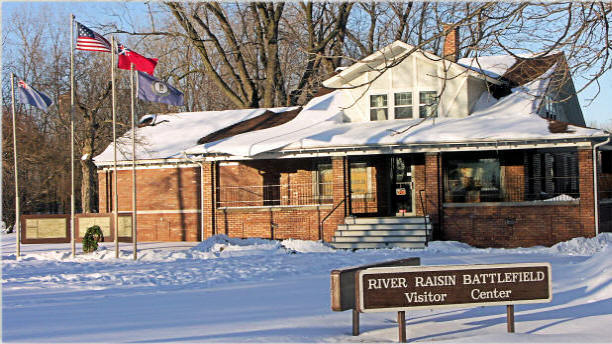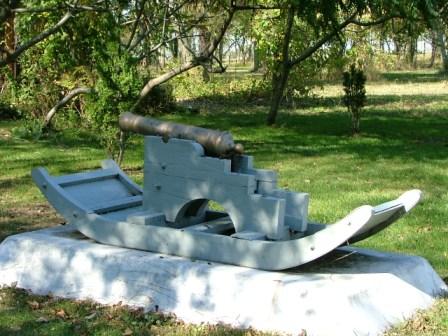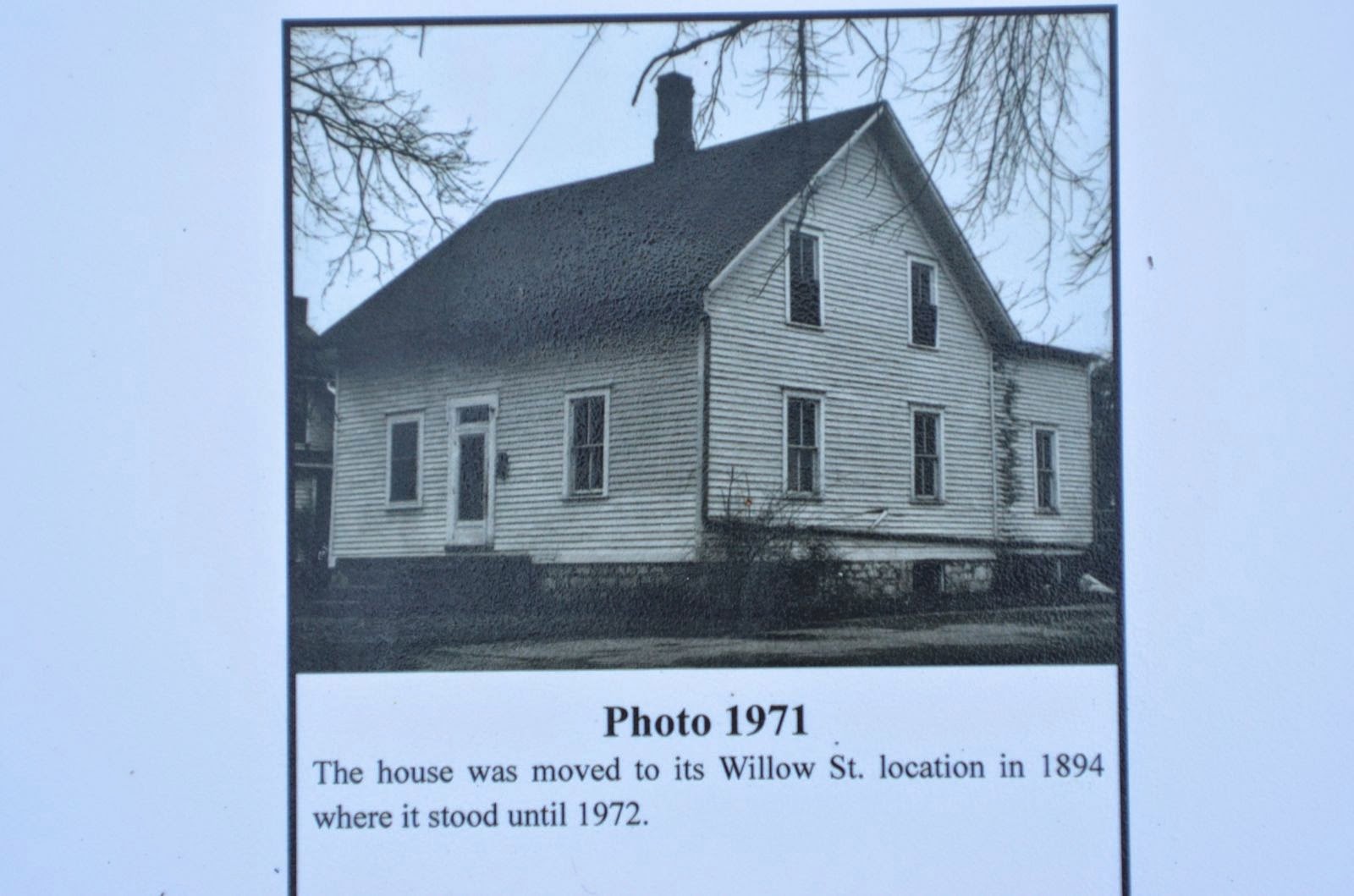Quite honestly, I had never heard of of this battle during our War of 1812 period.
From Wiki: The River Raisin Battlefield Site was listed as a Michigan Historic Site on February 18, 1956, although the exact date at which the park was first organized is unknown. The location of the site is bounded by North Dixie Highway, the River Raisin, Detroit Avenue, and Mason Run Creek. While the Battle of Frenchtown is so named because it took place within Frenchtown, the primary area of the battlefield is within the present-day city limits of Monroe. The area of conflict extended during the three days of battle several miles to the north and south of the current park site. The current park area encompasses some 40 acres of undeveloped land on Monroe’s east side approximately one-quarter mile east of Interstate 75.
The Park is one of smallest you'll ever visit, but the large historic marker boards tells the story of the battle fairly well. Inside the visitor center, one of the park volunteers uses a large battlefield wall board with lights that illustrate the movement of the British & American troops during the three-day battle. I borrowed the below pic from a website online.

Other than these large markers and the artifacts and displays inside the visitor center, there isn't much to look at. However, the 20 minute (actually 35 minutes) talk was very informative and gave one a good perspective of the battle when viewing the grounds with the River Raisin just to the south about 200 yards.
I realize that these maps are are hard to visualize, but I thought I would share in case I have a Revolutionary War historian happening upon this blog.
Not much can be found about this man, but there is info on his family. Mr Labady (Labadie) bore Colonel Johnson from the filed of battle. This monument was for him when he passed in 1846, but I believe he was interred at a sit in Monroe town.

British canon mounted on a sled...
Over this ground, Jan. 18, 1813, 667 Kentuckians and nearly 100 local Frenchmen charged across the frozen river toward the British and Indian positions. The 63 British and Canadian soldiers and 200 Potawatomi Indians made a brief stand there, then retreated with their cannon into a wooded area a mile to the north where the fighting raged for several hours...Across this ground during the second battle, Jan. 22, the Indians closely pursued the retreating U.S. 17th Infantry and its reinforcements. They tried to reform on the south bank, but became disorganized among farm lot buildings and fence rows. Constantly out flanked by mounted Indians, they fled south along a narrow lane, being fired on from both sides. Below and straight out from Nancy is the battlefield and directly behind me is River Raisin.
Above, a display of the Kentucky Volunteers and below River Raisin in downtown Monroe. Just to the left is the statue of George Custer on his mount.
Civil War Major General George Armstrong Custer first came to Monroe with his half sister Lydia in 1849 when he was ten-years-old to attend school two-years at the New Dublin primary school. He went back to his parents in New Rumley, Ohio. In 1853, at the age of 14, George Custer returned to Monroe for two-years of study at the Stebbins Academy. While in Monroe this second time he met a young Elizabeth (Libbie) Bacon. His impression of Ms. Bacon was lasting enough for him to return eleven-years later, during the height of the Civil War, in 1864 and marry her. Custer graduated as a second lieutenant from the U.S. Military Academy at West Point in 1861. During the Civil War the young Custer fought as a cavalry officer at the Battle of Bull Run, Gettysburg, and numerous other battles, drilled new recruits and helped defend the nation's capital, and served in the Army of the Potomac. After the War Between the States, Lieutenant Colonel Custer carried out War Department policy in regard to the various Native American tribes in the West as settlers began a massive migration west that would put them in direct competition for land and food that sustained wandering Indian tribes.
Below, and just across the street from his statue, General George Armstrong Custer, and prominent resident of Monroe was married to Elizabeth “Libbie” Bacon in the First Presbyterian Church by Reverend Boyd on February 9, 1864. Though the Custer family were Methodists, the young General Custer had fallen away from the Methodist Church and changed his faith to that of his bride-to-be. Libbie was the daughter of Judge Bacon whose family were long-time residents of Monroe and devote Presbyterians. The Reverend Boyd whose status as confidant over the years figured greatly in the lives of both families.
Across town about five miles away, up the Raisin River was this trading post.
The Navarre-Morris cabin at 200: next to the oldest wooden structure in Michigan, the Navarre-Anderson Trading Post in Monroe, sits an often overlooked cabin. Yet, because of its architectural style, connections to the founding family of Frenchtown, and its possible role in the War of 1812, this tiny structure has quite a history of its own.
Francis Navarre would come to be known as the founder of Frenchtown (part of present-day Monroe). He was the nephew of Francois Marie "Hutreau" Navarre, who erected the trading post building in 1789.
Old bullet holes mark where past hostilities were recorded in the wood log siding.
Above, an old replica oven and below, Miss Nancy reading about the structures past refurbishment efforts. And I have provided the photos that were on that storyboard below.
And just behind Nancy about 50 yards from that storyboard is the River Raisin.
And that's a wrap on our visit to Monroe, MI and the rich history of the area. We left Harbortown RV Park Thursday afternoon Sept 25 and headed to Cleveland and the Rock & Roll Hall of Fame. And that will be the topic of our next blog. So, till then, RVing Beach Bums signing off. This blog was written & published from our home in Virginia Beach, Dec 24, 2014.







































This is incredibly helpful, thank you for your careful documentation!
ReplyDelete